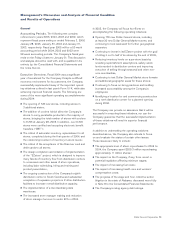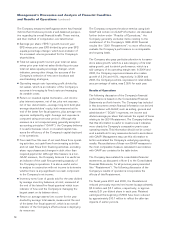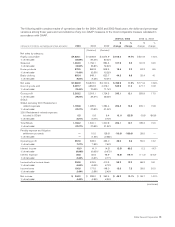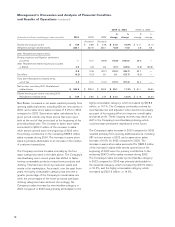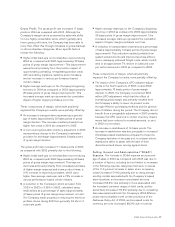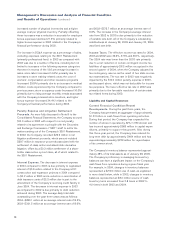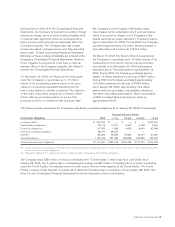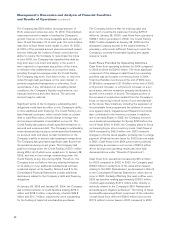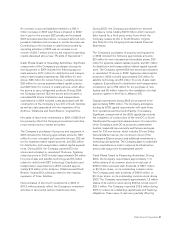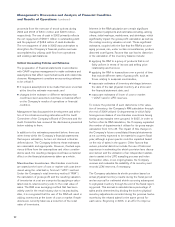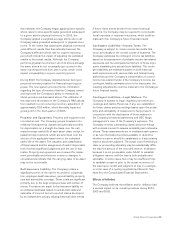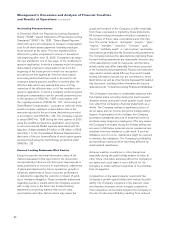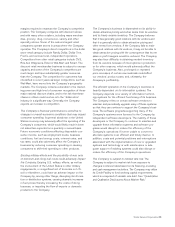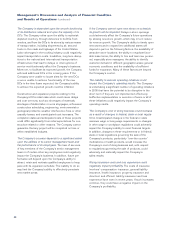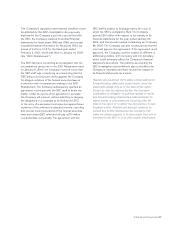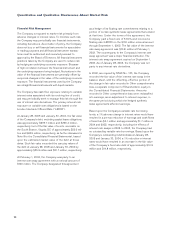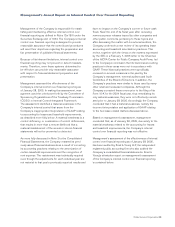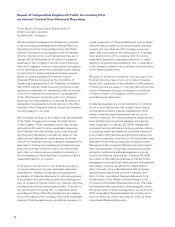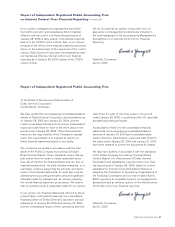Dollar General 2004 Annual Report Download - page 25
Download and view the complete annual report
Please find page 25 of the 2004 Dollar General annual report below. You can navigate through the pages in the report by either clicking on the pages listed below, or by using the keyword search tool below to find specific information within the annual report.Dollar General Corporation 23
this estimate, the Company began applying store-specific
shrink rates to store-specific sales generated subsequent
to a given store’s physical inventory. In 2002, the
Company applied a weighted-average shrink rate to all
Company sales generated subsequent to physical inven-
tories. To the extent that subsequent physical inventories
yield different results than this estimated accrual, the
Company’s effective shrink rate for a given reporting
period will include the impact of adjusting the estimated
results to the actual results. Although the Company
performs physical inventories in all of its stores annually,
the same stores do not necessarily get counted in the
same reporting periods from year to year, which could
impact comparability in a given reporting period.
During 2003, the Company implemented an item-level
perpetual inventory system for financial reporting pur-
poses. The new system provided better information
regarding the type of inventory that the Company owned
and improved the Company’s ability to estimate its
shrink provision as discussed above. The utilization of
this improved information in the Company’s RIM calcula-
tion resulted in a non-recurring inventory adjustment of
approximately $7.8 million, which favorably impacted
gross profit in the third quarter of 2003.
Property and Equipment. Property and equipment are
recorded at cost. The Company groups its assets into
relatively homogeneous classes and generally provides
for depreciation on a straight-line basis over the esti-
mated average useful life of each asset class, except for
leasehold improvements, which are amortized over the
shorter of the applicable lease term or the estimated
useful life of the asset. The valuation and classification
of these assets and the assignment of useful depreciable
lives involves significant judgments and the use of esti-
mates. Property and equipment are reviewed for impair-
ment periodically and whenever events or changes in
circumstances indicate that the carrying value of an asset
may not be recoverable.
Self-Insurance Liability. The Company retains a
significant portion of the risk for its workers’ compensa-
tion, employee health insurance, general liability, property
loss and automobile coverage. These costs are significant
primarily due to the large employee base and number of
stores. Provisions are made to this insurance liability on
an undiscounted basis based on actual claim data and
estimates of incurred but not reported claims developed
by an independent actuary utilizing historical claim trends.
If future claim trends deviate from recent historical
patterns, the Company may be required to record addi-
tional expenses or expense reductions, which could be
material to the Company’s future financial results.
Contingent Liabilities—Income Taxes. The
Company is subject to routine income tax audits that
occur periodically in the normal course of business. The
Company estimates its contingent income tax liabilities
based on its assessment of probable income tax-related
exposures and the anticipated settlement of those expo-
sures translating into actual future liabilities. The contin-
gent liabilities are estimated based on both historical
audit experiences with various state and federal taxing
authorities and the Company’s interpretation of current
income tax-related trends. If the Company’s income tax
contingent liability estimates prove to be inaccurate, the
resulting adjustments could be material to the Company’s
future financial results.
Contingent Liabilities—Legal Matters. The
Company is subject to legal, regulatory and other pro-
ceedings and claims. Reserves, if any, are established
for these claims and proceedings based upon the proba-
bility and estimability of losses and to fairly present, in
conjunction with the disclosures of these matters in
the Company’s financial statements and SEC filings,
management’s view of the Company’s exposure. The
Company reviews outstanding claims and proceedings
with external counsel to assess probability and estimates
of loss. These assessments are re-evaluated each quarter
or as new information becomes available to determine
whether a reserve should be established or if any existing
reserve should be adjusted. The actual cost of resolving a
claim or proceeding ultimately may be substantially differ-
ent than the amount of the recorded reserve. In addition,
because it is not permissible under GAAP to establish
a litigation reserve until the loss is both probable and
estimable, in some cases there may be insufficient time
to establish a reserve prior to the actual incurrence of
the loss (upon verdict and judgment at trial, for example,
or in the case of a quickly negotiated settlement). See
Note 8 to the Consolidated Financial Statements.
Effects of Inflation
The Company believes that inflation and/or deflation had
a minimal impact on its overall operations during 2004,
2003 and 2002.


